Carlota of Mexico
| Carlota of Mexico (Charlotte of Belgium) | |||||
|---|---|---|---|---|---|
 | |||||
| Empress consort of Mexico | |||||
| Tenure | 10 April 1864 – 15 May 1867 | ||||
| Coronation | 10 April 1864 | ||||
| Born |
7 June 1840 Laeken, Brussels, Belgium | ||||
| Died |
19 January 1927 (aged 86) Meise, Belgium | ||||
| Burial | Royal Crypt, Laken | ||||
| Spouse | Maximilian I of Mexico | ||||
| |||||
| House | Saxe-Coburg and Gotha | ||||
| Father | Leopold I of Belgium | ||||
| Mother | Louise of Orléans | ||||
| Religion | Roman Catholicism | ||||
Carlota of Mexico (Marie Charlotte Amélie Augustine Victoire Clémentine Léopoldine; 7 June 1840 – 19 January 1927) was a Belgian princess who became Empress of Mexico as the wife of Maximilian I of Mexico.
Princess of Belgium
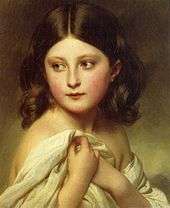
The only daughter of Leopold I, King of the Belgians (1790–1865) by his second wife, Louise, Princess of Orléans (1812–1850), Charlotte was born at the Royal Palace of Laeken in Laeken, Brussels, Belgium. Charlotte had three brothers: Louis-Philippe, who died in infancy, Leopold, who on the death of their father became Leopold II of Belgium and Philippe, Count of Flanders. She was also a first cousin to both Queen Victoria and her husband, Prince Albert, as well as Ferdinand II of Portugal. She belonged to the House of Saxe-Coburg and Gotha.
Her favorite grandparent Maria Amalia of the Two Sicilies, Queen of France, was the consort of Louis-Philippe of France, and a niece of Marie Antoinette. Maria Amalia was Charlotte's close confidante, and on her wedding day in 1857, she wore a bracelet with a miniature portrait of her. They regularly corresponded, especially later while Charlotte was in Mexico.
When Charlotte was ten years old, her mother, Louise-Marie, died of tuberculosis and Charlotte was entrusted to the Countess of Hulste, a close family friend. Although young, the princess had her own household; but for a few weeks out of the year, Charlotte stayed in Claremont with Maria Amalia and the rest of her mother's family in exile.
Archduchess of Austria
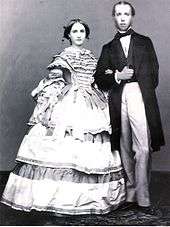
On 27 July 1857 in Brussels, Charlotte married her second cousin Archduke Maximilian of Austria, the idealistic younger brother of Emperor Franz Joseph I of Austria. Napoleon III gave Charlotte and her husband Maximillian a beautiful bisque bust of Charlotte as a wedding gift. This bust is in the Pope's Tavern, Florence, Alabama, United States. In the Court of Vienna she was much prized by her mother-in-law, Princess Sophie, who saw in her the perfect example of a wife to an Austrian Archduke. Charlotte disliked Empress Elisabeth (also known as Sissi), Franz Joseph's wife. It is said that the archduchess disliked the deep connection that existed between the empress and Maximilian, who were confidantes and shared the same tastes for many things, especially because her sister-in-law was universally admired for her beauty and charms.
Charlotte spent several relatively happy years in Italy as Maximilian's wife while the archduke served as the governor of the Austrian provinces of Lombardy and Venetia. The position was purely nominal, as power rested in the hand of the Emperor and his officers.
Empress of Mexico
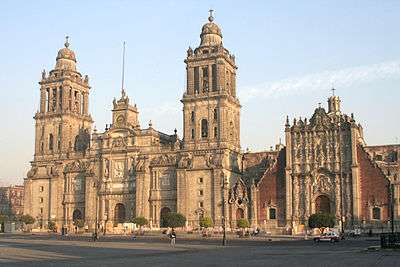
In the early 1860s, the ambitious Napoleon III initiated the French intervention in Mexico. France, eager to turn Mexico into a satellite state, searched for a suitable figurehead to serve as the nominal emperor of Mexico. His choice was Maximilian, who held no real power in Italy and was eager for a more challenging role. Against his brother's advice, Maximilian accepted the Mexican crown and the couple sailed for the New World.[1] The imperial couple were crowned at the Catedral Metropolitana in 1864 and chose as their seat Mexico City, making their home in the Neoclassical Chapultepec Castle. As Empress, she took the name of Carlota (Spanish for Charlotte). Carlota tried to take her imperial duties seriously, and even undertook a tour of the remote Yucatán frontier, visiting the ruins of Uxmal.
Only months after the coronation, however, Napoleon III began signaling his abandonment of Maximilian, and the French began to withdraw their troops from Mexico. This strategic pullback was a potentially fatal blow to the infant Mexican monarchy. The situation was exacerbated by a United States blockade that prevented French reinforcements from landing. In a desperate attempt to save her husband's throne, Carlota returned to Europe, seeking assistance for her husband in Paris, Vienna, and finally in Rome from Pope Pius IX. Her efforts failed; she manifested symptoms of paranoia, suffered a profound cognitive and emotional collapse, and never returned to Mexico.
Family

Carlota and Maximilian had no children, but in 1865 the imperial couple adopted Agustín de Iturbide y Green and Salvador de Iturbide y de Marzán—grandsons of Agustín de Iturbide y Arámburu, an earlier emperor of Mexico (r. 1822–23). They gave two-year-old Agustín the title of "His Highness, The Prince of Iturbide"—similar imperial titles were accorded to various members of the child's extended family—but never intended to give him the throne, because he was not of royal blood.[2] Maximilian explained himself that it was all a charade to get his brother Archduke Karl Ludwig of Austria to give him one of his sons as heir.[2] The explosive events of 1867 dashed any hopes of inheritance, and after he grew to adulthood, Agustín renounced all rights to the Mexican throne, served in the Mexican army, and eventually established himself as a professor at Georgetown University.
Rumors persist that, in 1866, Carlota was having an affair with Belgian officer Colonel Alfred Van der Smissen and that she gave birth to a son, Maxime Weygand, in Brussels on 21 January 1867. Weygand refused to confirm or deny the persistent rumor and his parentage remains uncertain. Weygand was a French military commander in both World Wars I and II.[3]
empress Dowager
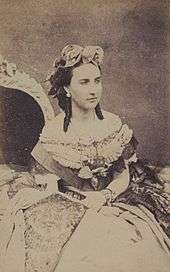

The empress was sent to Europe in 1866 to find help with Family.[4] She was received both by the French Emperor and later by the pope in audience, unfortunately whiteout success. She was possessed by the idea that she would be killed by poison and refused to eat normal food. Her secretary Batti was horrified when she drunk public water from the fountains in Rome[5], she even bought a cat to taste her food. King Leopold was shocked and sent the count of Flanders to Italy to visit his sister. The Empress who was very depressed and unstable took her court in Miramar, on advise of her brother the Count of Flanders.[6] Dr. Riedel, Director of the Lunatic Asylum of Vienna visited her, to report the Emperor.
Miramar
Wile the Empress was resting the Emperor of Austia and the King of Belgium sent delegations to Miramar. The Count of Bombelles, [7] and Dr von Jilek a friend of the Emperor of Mexico were sent to Miramar.[8] The king of Belgium sent baron Auguste Goffinet on mission to get his sister home, the emperor was executed in Mexico. Now archduchess again, she was obidient to the austrian court, and Count Karl of Bombelles tried to keep her in Miramar. Discussions between the imperial court and Brussels became more important, because of the heritage. The emperor placed Charlotte under custody of his brother Archduke Karl Ludwig of Austria. The king sent his wife to Vienna tot visit her Cousin emperor Frans-Josef and take care of Charlotte.
There she was kept in observance by a team of medical and imperial guards. The king sent Jan Frans Bulckens 1813-1876[9] Psychiater of Belgium to his sister.[10] The medical team decided that the empress could not be told of the execution of her husband. By medical approval the Queen gave her sister in law a faked Telegram, from her husband to come back to Brussels.
This worked and the empress-dowager left Miramare Castle for the last time. Togheter with her sister-in law, Queen Marie Henriette and the Belgian delegation they left for Belgium. After she left Miramare Castle was returned property to the imperial Court.
Historians think that after the death of the Emperor in Mexico; Charlotte only had status of a rich dowager. For the Viennese court and imperial family it was of financial interrest to keep her in Miramar. There her fortune was guarded under care of Eduard von Radonetz, the prefect of Miramar. When she was in Belgium the Viennes court would need to pay her sowry to Leopold in Belgium. This theory is confirmed by André Castelot.[11]
final years and Death
At the end the Austrian delegation allowed the empress and her sister in law leave to Belgium were the king gifted her court at the Castle of Bouchout in Meise, Belgium. During the final years of his life the king cared of his sister. The dowager wrote notes of profound gratitude of the care she received of her brother and nephews.[12]
During World War I, her Belgian estate was surrounded by the occupying German army, but the estate itself was sacrosanct because Austria-Hungary was one of Germany's chief allies and she was the widowed sister-in-law of the Austrian emperor.
As Carlota 's illness progressed, her paranoia faded. She remained deeply in love with her husband. After his death, she cherished all of the surviving possessions they had enjoyed in common. The bias of the historiography of the time makes it difficult to assess to what extent she suffered from alleged mental conditions such as psychosis, paranoia and monomania.
Carlota died of pneumonia brought on by influenza at the Bouchout Castle, in Meise, Belgium, on 19 January 1927, and is buried in the Royal Crypt of the Church of Our Lady of Laeken.
She was the last surviving child of Leopold I.
Titles, styles, honours and arms
| Styles of Carlota of Mexico | |
|---|---|
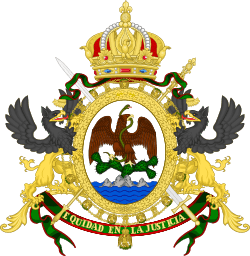 | |
| Reference style | Her Imperial Majesty |
| Spoken style | Your Imperial Majesty |
| Alternative style | Ma'am |
Titles and styles
- 7 June 1840 - 27 July 1857: Her Royal Highness Princess Charlotte of Belgium, Princess of Saxe-Coburg and Gotha
- 27 July 1857 - 10 April 1864: Her Imperial and Royal Highness Archduchesses and Princess Charlotte of Austria, Prince of Hungary and Bohemia
- 10 April 1864 - 19 June 1867: Her Imperial Majesty The Empress of Mexico
- 19 June 1867 - 19 January 1927: Her Imperial Majesty The Dowager-Empress Charlotte of Mexico
Grand Master
During the Second Mexican Empire, she was the Grand Master of the :
- Imperial Order of Saint Charles (founded in April 1866),
It was a women-only order consisting of maximum 24 "Grand Crosses" and an unlimited number of "Crosses". It was named after her patron, Saint Charles Borromeo. Being the wife of a member of the Imperial Family of Austria, the Order of the Starry Cross seems a probable model.
Received honours
Carlota of Mexico received the following honours:[13]
-
 Austrian Empire: Dame of the Order of the Starry Cross
Austrian Empire: Dame of the Order of the Starry Cross -
 Spain : 525th Dame of the Order of Queen Maria Luisa
Spain : 525th Dame of the Order of Queen Maria Luisa -
 Malta : Dame Grand Cross of Honour and Devotion of the Sovereign Military Order of Malta
Malta : Dame Grand Cross of Honour and Devotion of the Sovereign Military Order of Malta
Ancestry
In popular culture

- Medea de Novara portrayed Empress Carlota in the films Juárez y Maximiliano (1934), La paloma (1937), The Mad Empress (1939) and Caballería del imperio (1942), all directed by de Novara's husband, director Miguel Contreras Torres.[14]
- Bette Davis portrayed Empress Carlota in the film Juarez (1939), directed by William Dieterle.[15]
- Carlota is referenced in the first season of The Dick Van Dyke Show in an episode titled "Empress Carlotta's Necklace" (1961).
- María Rivas portrayed the Empress in the historical telenovela Maximiliano y Carlota (1965).[16]
- Nelly Meden portrayed Empress Carlota in another historical telenovela, El carruaje (1972).
- News from the Empire (Spanish: Noticias del Imperio, 1986), a novel by Fernando del Paso, shows a literary portrait of the Empress and her madness.
- Marisol Santacruz portrayed Empress Carlota in an episode of the Mexican documentary television series Secretos de nuestra historia (2006), which features "virtual interviews" with historical figures of Mexico.[17][18]
- The musical Carlota: A Serpentine Crown (2009), by composer and scenarist Marcel Wick, portrays Carlota as a woman driven by ambition towards inevitable disaster.
- The American film production company Two M Films has announced a project entitled "Bringing Back Charlotte". The company gained exclusive access to the archives of the Belgian royal palace, and were allowed to read the letters the empress had written to her father and brothers, while being in Mexico. Belgian born writer/director Maxime Brulein is said to direct the film, for which he wrote the screenplay.[19]
See also
References
- ↑ Royal Ark
- 1 2 Villalpando, José Manuel; Rosas, Alejandro (2011). Presidentes de México. Grupo Planeta Spain. n.p. ISBN 9786070707582.
- ↑ Haslip, Joan. The Crown of Mexico. ISBN 0-03-086572-7.
- ↑ De terugkeer van Charlotte Paperback. Juli 1867 - een delicate opdracht voor baron Adrien Goffinet, Université de Genève
- ↑ De terugkeer van Charlotte Paperback. Juli 1867 - een delicate opdracht voor baron Adrien Goffinet, Université de Genève
- ↑ De terugkeer van Charlotte Paperback. Juli 1867 - een delicate opdracht voor baron Adrien Goffinet, Université de Genève
- ↑ De terugkeer van Charlotte Paperback. Juli 1867 - een delicate opdracht voor baron Adrien Goffinet, Université de Genève
- ↑ De terugkeer van Charlotte Paperback. Juli 1867 - een delicate opdracht voor baron Adrien Goffinet, Université de Genève
- ↑ De terugkeer van Charlotte Paperback. Juli 1867 - een delicate opdracht voor baron Adrien Goffinet, Université de Genève
- ↑ De terugkeer van Charlotte Paperback. Juli 1867 - een delicate opdracht voor baron Adrien Goffinet, Université de Genève
- ↑ Maximilien et Charlotte du Mexique : La tragédie de l'ambition
- ↑ G. FREDDY, Léopold II intime, Parijs, 1905
- ↑ Buyers, Christopher (2009). "Mexico—The Habsburg Dynasty—Genealogy". The Royal ark (royalark.net). Retrieved 1 March 2013.
- ↑ "Medea de Novara". Internet Movie Database. Retrieved 27 January 2015.
- ↑ "Bette Davis Is Empress In 'Juarez'". The Register-Guard. Retrieved 27 January 2015.
- ↑ "Telenovela Carlota y Maximiliano (1965)". YouTube. Retrieved 27 January 2015.
- ↑ "1/2 Entrevista Virtual, Emperatriz Carlota de México (Charlotte de Belgique)". YouTube. Retrieved 27 January 2015.
- ↑ "2/2 Entrevista Virtual, Emperatriz Carlota de México (Charlotte de Belgique)". YouTube. Retrieved 27 January 2015.
- ↑ "Charlotte de Belgique à Hollywood". Cinetelerevue.be. 22 January 2014. Retrieved 1 February 2014.
Further reading
- Prince Michael of Greece (1998). The Empress of Farewells: The Story of Charlotte, Empress of Mexico. New York..
- del Paso, Fernando (1987). Noticias del Imperio. México.
- Bibesco, Princesse Marthe (1962). Charlotte et Maximilien. Paris.
- Castelot, André (1985). Maximiliano y Carlota. La Tragedia de la Ambición. México.
- Corti, Conte Egon Caesar (1924). Maximilian und Charlotte von Mexiko. Nach dem bisher unveröffentlichten Geheimarchive des Kaisers Maximilian und sonstigen unbekannten Quellen. 2 vols. Zurich, Leipzig, Viena.
- Corti, Conte Egon Caesar (1953). Maximilian von Mexiko. Die Tragödie eines Kaisers. Francfort del Meno.
- Desternes, Suzanne; Chandet, Henriette (1964). Maximilien et Charlotte. Paris.
- Gómez Tepexicuapan, Amparo (2001). Igler, Susanne; Spiller, Roland, eds. Carlota en México. Más nuevas del imperio. Francfort del Meno: Estudios interdisciplinarios acerca de Carlota de México. pp. 27–40.
- Miguel de Grecia (2000). La Emperatriz del Adiós. El trágico destino del emperador Maximiliano y su mujer Carlota. Barcelona.
- Harding, Bertita (1934). Phantom Crown: The story of Maximilian and Carlota of Mexico. New York.
- Haslip, Joan (1972). The Crown of Mexico: Maximilian and his Empress Carlota (2nd ed.). New York.
- Hyde, Montgomery H. (1946). Mexican Empire. The history of Maximilian and Carlota of Mexico. London.
- Igler, Susanne (2002). Carlota de México. Mexico.
- ——— (2006). Carlota de México. Grandes Protagonistas de la Historia Mexicana (2nd ed.).
- ——— (2007). De la intrusa infame a la loca del castillo: Carlota de México en la literatura de su 'patria adoptiva'. Frankfurt: Peter Lang.
- Kerckvoorde, Mia (1981). Charlotte: La passion et la fatalité. Paris.
- Maria y Campos, Armando (1944). Carlota de Bélgica: La infortunada Emperatriz de México. México.
- Praviel, Armand (1937). La vida trágica de la emperatriz Carlota. Buenos Aires.
- Ridley, Jasper (2001). Maximilian & Juarez. London: Phoenix Press.
External links
| Wikimedia Commons has media related to Charlotte of Belgium, Empress of Mexico. |
- Imperial House of Mexico
- Biography of Charlotte of Belgium (1840–1927)
- Carlota of Mexico at Find a Grave
- Works by or about Carlota of Mexico at Internet Archive
- 1923 Newspaper Interview with one of Carlota's Ladies (in Spanish)
- C.M. Mayo's blog for researchers of Mexico's Second Empire, a period also known as the French Intervention"
- An Account of the French Intervention and the 2nd Mexican Empire, 1862–1867.
| Carlota of Mexico Cadet branch of the House of Wettin Born: June 1840 Died: 19 January 1927 | ||
| Mexican royalty | ||
|---|---|---|
| Vacant Title last held by Ana María de Huarte y Muñiz |
Empress Consort of Mexico 10 April 1864 – 15 May 1867 |
Monarchy abolished |
| Titles in pretence | ||
| Vacant Title last held by Ana María de Huarte y Muñiz |
— TITULAR — Empress Consort of Mexico 15 May 1867 – 19 June 1867 | |